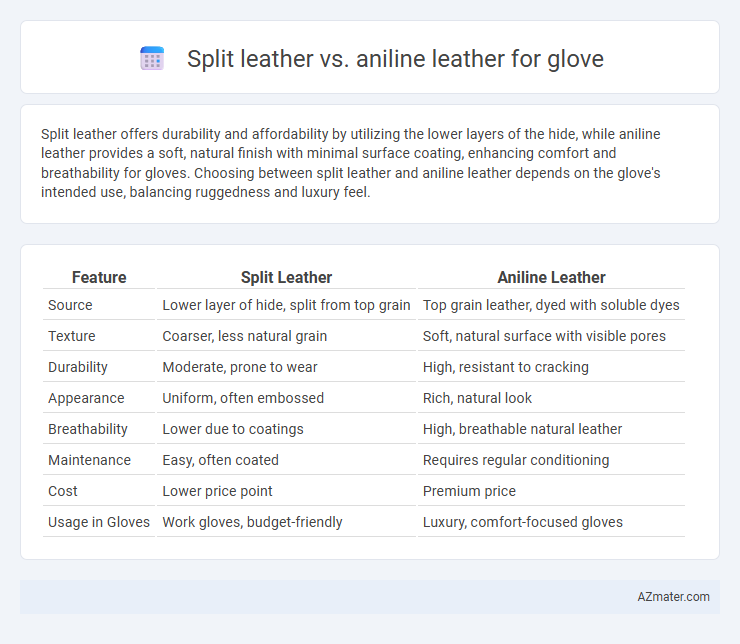Split leather offers durability and affordability by utilizing the lower layers of the hide, while aniline leather provides a soft, natural finish with minimal surface coating, enhancing comfort and breathability for gloves. Choosing between split leather and aniline leather depends on the glove's intended use, balancing ruggedness and luxury feel.
Table of Comparison
| Feature | Split Leather | Aniline Leather |
|---|---|---|
| Source | Lower layer of hide, split from top grain | Top grain leather, dyed with soluble dyes |
| Texture | Coarser, less natural grain | Soft, natural surface with visible pores |
| Durability | Moderate, prone to wear | High, resistant to cracking |
| Appearance | Uniform, often embossed | Rich, natural look |
| Breathability | Lower due to coatings | High, breathable natural leather |
| Maintenance | Easy, often coated | Requires regular conditioning |
| Cost | Lower price point | Premium price |
| Usage in Gloves | Work gloves, budget-friendly | Luxury, comfort-focused gloves |
Introduction to Split Leather and Aniline Leather
Split leather, derived from the fibrous underside of a hide, offers durability and cost-efficiency, making it a popular choice for glove manufacturing. Aniline leather, treated with transparent dyes that preserve the hide's natural texture and markings, provides a soft, breathable, and luxurious feel ideal for premium gloves. Understanding these leather types helps in selecting gloves that balance appearance, comfort, and longevity.
What is Split Leather?
Split leather is derived from the lower layers of a cowhide after the top grain has been separated, resulting in a more porous and less durable material compared to Aniline leather. In gloves, split leather offers increased flexibility and affordability but may lack the natural texture and breathability found in Aniline leather, which is dyed without surface coating to preserve its softness. Choosing split leather for gloves provides a cost-effective option with moderate durability, while Aniline leather offers superior quality and a more luxurious feel.
What is Aniline Leather?
Aniline leather is a type of high-quality leather dyed exclusively with soluble dyes, preserving the natural surface. This method retains the leather's softness, breathability, and visible grain, making gloves made from aniline leather highly durable and comfortable. In contrast, split leather comes from the lower layers of the hide and is usually coated or finished, offering less natural texture and durability for glove production.
Key Differences Between Split Leather and Aniline Leather
Split leather is made from the lower layers of a hide, offering durability but less softness compared to aniline leather, which is crafted from the top grain of the hide for a more natural, supple feel. Aniline leather is dyed with soluble dyes without a surface coating, preserving the hide's natural texture and breathability, whereas split leather undergoes heavy processing and often features a synthetic finish to improve appearance and resistance. For gloves, aniline leather provides superior comfort and flexibility, while split leather delivers enhanced durability and cost-effectiveness.
Durability Comparison: Split vs Aniline Leather
Split leather gloves offer enhanced durability due to their thicker, fibrous layers derived from the lower portion of the hide, making them resistant to abrasion and wear. Aniline leather, crafted from the top grain with minimal surface treatment, prioritizes softness and breathability but tends to be more susceptible to scratches and stains. For gloves exposed to heavy use or rough conditions, split leather provides superior longevity, whereas aniline leather suits environments requiring more flexibility and natural feel with moderate durability.
Comfort and Flexibility in Gloves
Split leather offers durability and a rougher texture, but tends to be less flexible and breathable compared to aniline leather. Aniline leather, made from the top grain, provides superior softness and flexibility, enhancing comfort for prolonged glove wear. The natural, uncoated surface of aniline leather allows better moisture absorption, contributing to improved glove breathability and overall comfort.
Visual Appeal and Color Retention
Aniline leather gloves offer a rich, natural appearance with visible grain and a soft, smooth texture that enhances visual appeal, while split leather gloves tend to have a more uniform but less vibrant look due to their processed lower layers. Split leather's color retention is typically superior because it often undergoes pigment dyeing and surface coatings, ensuring longer-lasting hues compared to aniline leather, which uses transparent dyes that highlight natural imperfections but can fade faster. Choosing between split and aniline leather for gloves depends on prioritizing either authentic, natural aesthetics or durable, consistent color over time.
Maintenance and Care Requirements
Split leather requires more frequent conditioning and protection from moisture to prevent cracking and stiffness, as it is less durable than top-grain leather. Aniline leather, known for its natural finish and softness, demands gentle cleaning with specific leather cleaners and minimal exposure to direct sunlight to maintain its appearance and suppleness. Proper maintenance of both types involves avoiding harsh chemicals and storing gloves in a cool, dry place to extend their lifespan.
Price and Value for Money
Split leather gloves offer a budget-friendly option by utilizing the fibrous underside of the hide, providing durability at a lower cost compared to top-grain options. Aniline leather gloves, crafted from premium top-grain hides with a transparent dye finish, command higher prices due to their superior softness, breathability, and natural appearance. For value-conscious buyers, split leather delivers affordability and decent durability, while aniline leather justifies its premium price with enhanced comfort and luxury feel.
Which Leather is Best for Gloves?
Aniline leather offers a soft, natural finish with high breathability, making it ideal for gloves requiring comfort and flexibility, while split leather is more durable and cost-effective, suited for gloves needing extra strength and resistance. Aniline leather is preferred for premium gloves due to its superior suppleness and moisture absorption, whereas split leather excels in rugged performance applications. Choosing the best leather depends on the glove's intended use, prioritizing softness and tactile sensitivity with aniline or toughness and affordability with split leather.

Infographic: Split leather vs Aniline leather for Glove
 azmater.com
azmater.com